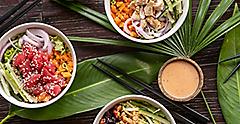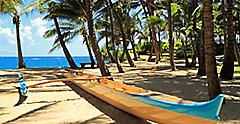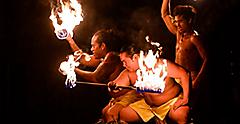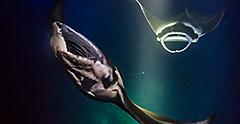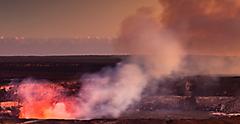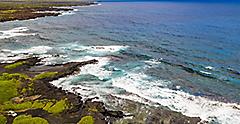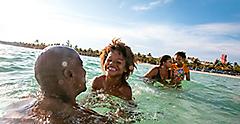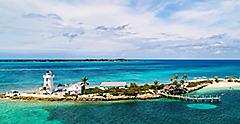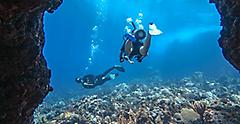Surf In The Hawaiian Waters To Honor The Cultures Birthplace

As soon as I pop up and the soles of my feet make contact with my board, it feels like I'm weightless — like I'm flying. To my left, I catch the sparkle of Honolulu's skyscrapers glimmering against the sunlight. To my right, I admire the curvy silhouette of Diamond Head, a volcanic crater formed over 400,000 years ago. I'm surfing in Hawaii, one of the most incredible surf destinations in the world.
Gliding down the face of a wave at Waikiki is one of the most iconic experiences to have in Hawaii, and it's one shared by a long legacy of surfers. Most surf historians cite Hawaii as the birthplace of modern surfing, and there are few better places to learn than the friendly waves of Waikiki.
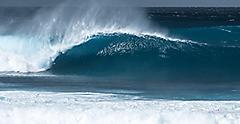
Savor Hawaii's Many Islands Flavors
Hawaii's cuisine is just as diverse as the rest of its culture, and the flavors embody the very best parts of Hawaii's history. It's a true melting pot, and one such popular dish where this shines through is poke, a bowl of raw fish mixed with sauce, spices and fresh toppings. You'll find poke everywhere, from roadside food trucks to fine dining venues, each with their own twist. Get it tangy, spicy, sweet or all three — the options are endless.
One thing I learned repeatedly after many trips visiting the islands of Hawaii is that you must save plenty of room in your suitcase to bring back bags of macadamia nuts. It is one of my favorite things to do in Maui, they spice the macadamias in ways you might not have thought possible. While piping hot roasted macadamia nuts are delicious by themselves, commit to sampling the flavored varieties for the ultimate experience. Start with the savory, then move to the sweet. Sweet Maui onion macadamias with a pinch of sea salt are my first love, though the honey roasted variety is a close second.
The rich volcanic soil of Hawaii and cool slopes of its mountains create an environment prime for coffee growing. Grab a cup of coffee made from Hawaiian coffee beans whenever possible, and pick up a bag to take home. Both Kauai and the island of Hawaii are famed for growing coffee beans that create a full-bodied flavor.
As you drive past the coffee farms and all the beauty Hawaii has to offer, you'll undoubtedly notice a number of colorful stands. Take a chance and pull over, as they're probably selling something tasty, like shaved ice, which is a scoop of snow drizzled in syrup that melts in your mouth as soon as it hits your tongue. One of the best parts of these little stands is that you'll likely get into conversation with the vendor. Ask a few questions about their life in Hawaii — you might be surprised by what you learn, and perhaps even more surprised by what you may have in common.
Paddle Traditional Canoes Of Ancient Polynesia
Just when I thought I'd mastered paddling an outrigger canoe in the calm bay of Honaunau, a small wave knocked me into the sea. Flipping an outrigger canoe is called a huli in Hawaiian, and once I learned how to right the canoe and climb back in, I discovered newfound freedom paddling along the island of Hawaii's coastline. Canoeing is Hawaii's traditional form of transportation, as Polynesians paddled through the South Pacific on double hulled and outrigger canoes.
Exploring Hawaiian waters with a paddle in hand is one of the best ways to experience the islands, just as the first Polynesians once did. There are multiple operators offering different paddling excursions, from guided paddling tours onboard double-hulled canoes in Keauhou Bay off Kona — where it's common to spot manta rays and spinner dolphins — to family-friendly tours that teach Hawaiian history and mythology in an outrigger canoe off of Wailea Beach, Maui. However, if there's one activity that needs to be on your Hawaii bucket list, it's onboarding a nine-person outrigger canoe and riding the waves of Waikiki.
Immerse Yourself In A Polynesian Cultural Performance
With the thunder of drumbeats, flashes of fire and costumes that emphasize every dramatic movement, the performances at the Polynesian Cultural Center on Oahu will make your heart race from the comfort of your seat. The center represents South Pacific island nations and offers sight into traditional Polynesian and Melanesian dance, music, food, craft and culture.
Between thrilling dances and presentations, you'll learn about the meaning behind Maori and Marquesan tattoos, Hawaiian hula, Tongan architecture, how to climb a coconut tree, the art of traditional fishing and how to throw a spear. It's an interactive experience that'll have you working up an appetite. Thankfully, you can hit the buffet at the luau.
Scuba Dive And Snorkel With Hawaii's Underwater Wildlife
From the ink-black waters below, a manta ray swoops toward the ocean's surface with its mouth wide open, feasting on the plankton that have gathered under the giant bright light I'm hanging onto. I hold my breath as the manta ray glides within inches of me. Another manta appears, and they flip and twirl like ballet dancers. Every night, these manta rays feed at Keauhou Bay, and it's possible to witness them on a scuba diving or snorkeling excursion. Come daytime, the reef comes alive at Kealakekua Bay State Historical Park. This is a fantastic spot to see eagle rays, sea turtles and humuhumunukunukuapuaa — the Hawaiian state fish.
Elsewhere around Hawaii, snorkeling excursions will take you under the sea, where sea turtles, rays, eels, reef sharks and hundreds of fish dance around colorful coral reefs and underwater lava tubes. Molokai, home to Hawaii's largest fringing reef, is famous for its rays, sea turtles and moray eels. Molokai might be a bit off the beaten path, but this stretch of untouched nature is well worth the detour.
Visit Volcanoes In Hawaii's National Parks And Memorials
A land of fire and ice, the island of Hawaii is one of earth's wildest landscapes. Hawaii Volcanoes National Park is where you can witness land being created firsthand from the active volcanoes of Kilauea and Mauna Loa. The lands of the park are sacred and feature heavily in Hawaiian mythology as the park is home to Pele, a deity devoted to creation and destruction. Conditions change from day to day; you might see plume from the volcanic crater puffing steam into the sky like a cloud factory on one visit, and lava flowing into the sea during the next. At night, gaze into a pit of molten lava for otherworldly amber hues. The park also hosts a range of hiking paths, like the Kilauea Iki trail that traverses over a solidified lava lake. It's a blazing contrast to Hawaii's dormant and often snow-capped volcano of Mauna Kea.
Haleakala National Park is a must add to your Maui bucket list as it is home to a dormant shield volcano like no other. According to Hawaiian mythology, Maui, the Hawaiian deity, placed the entirety of the sun inside of the Haleakala volcano. Take a day trip to this park for an ideal hiking and bird-watching. At night, the park's dark skies offer an opportunity to stargaze.
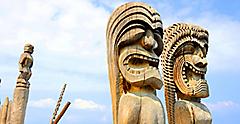
Pu'uhonua O Honaunau National Historical Park on the island of Hawaii is an important park — not only because of its natural landscape but also because it's one of the most culturally significant sites in the archipelago. When an ancient Hawaiian broke kapu, a sacred law, the punishment may have been death. If the lawbreaker could evade capture and take refuge in the borders of Pu'uhonua O Honaunau, he would be granted a new chance at life. A self-guided tour leads you through the park to discover fish traps, sacred temples called heiau and wooden carvings of ancient gods called kii.
While on the Oahu bucket list part of your Hawaii vacation, visit the Pearl Harbor National Memorial to learn about one of the most impactful moments in United States history, the 1941 Japanese attack on Pearl Harbor. Visit the USS Arizona Memorial dedicated to the United States Navy service members and civilians who lost their lives. This event led to the country's involvement in WWII. Today, the memorial presents educational programs and commemoration events.
Lace Up For Hiking In Hawaii On Natural Trailheads
Whether its escaping into lush rainforest in search of waterfalls, treading lightly on trails of hardened lava, walking along a soft sand beach or strolling through grasslands, there's no shortage of terrain to hike around in Hawaii.
While looking for things to do in Oahu the impressive skyline of Honolulu will certainly not be one you’ll want to miss out on seeing for yourself. The skyline can be seen from above by taking an extreme hike to the top of Diamond Head Crater, a family-friendly 1.6-mile out-and-back trail to the edge of a crater rim. At Waimea Falls Park, pack a bathing suit and shower off under a waterfall at the end of a trail that weaves through botanical gardens.
The island of Hawaii is the largest in the archipelago and home to a trail that's been designated as a National Historic Trail — the Ala Kahakai Trail. This trail spans over 175 miles, but it's best explored section by section. It weaves through sacred sites, lava flats, fields of wildflowers and along rocky shores. For a steep yet rewarding hike on the island of Hawaii, venture down Pololu Valley, a dirt trail leading to a rocky beach.
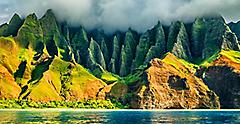
Rediscover Your Passion For The Beach
It may seem obvious, though between all the adventure and exploration, you'll want to slow down and take full advantage of the sandy beaches accenting the islands' shorelines. Beaches in Hawaii range from barely-there slivers of sand in a hidden cove to swaths of enough sand to accommodate hundreds of towels with plenty of room to spare. Sand hues span the color spectrum, including, black, light gray, white and even red and green.
Once you've had your fill of postcard-perfect beaches, retreat to an enclave that's more unusual — like the jet-black sand beaches of Honokalani on Maui or Punalu'u on the island of Hawaii. Leave footprints near the water that look as though they're filled with Merlot on the sands of Kaihalulu Beach on Maui, which gets its rose-colored hue from oxidized iron in the sand.
Your Hawaii bucket list for the ultimate island vacation could be never ending with all there is to do in this tropical paradise, and after several visits, I know that to be true. But what I always remember is that the "aloha" lifestyle will always be there, waiting for my return.
Get Royal Deals, Sign Up Today

Getting There
Explore Our Most Affordable Itineraries
Prepare to be captivated by the islands on your cruise to Hawaii.

